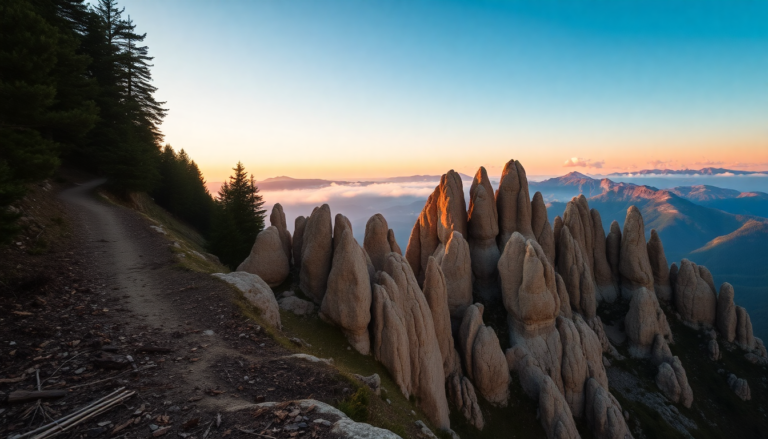Argomenti trattati
In the heart of the mystical Rodopi mountains, where whispers of ancient tales echo and sunsets bathe the rocks in a sacred light, lies a plateau that feels suspended between the skies and myths. This enchanting place, known as Belintash, captivates visitors with its ethereal beauty and deep historical significance, inviting everyone to embark on a journey through time and spirituality.
Belintash: A Portal to Ancient Mysteries
As you trek through dense forests, a palpable sense of anticipation builds with every step. Finally, you arrive at a colossal outcrop of white rock, stretching an impressive 300 meters long and perched at 1,225 meters above sea level. From this vantage point, you overlook the lush valleys of Bulgaria—a true terrace of the gods. Belintash, or Belantash as it’s sometimes referred to, is more than just an archaeological site; it’s a tapestry woven with mysteries, ancient cults, and chilling theories.
Could it be an alien landing site? Or perhaps an astronomical observatory used by the Thracians? Some even propose it as the secret refuge of Alexander the Great’s treasure. Each year, new legends and prophecies emerge, layering this timeless narrative where the concept of time itself seems to vanish.
Carved channels, ritual baths, inscriptions, and deep fissures divide the plateau into three sections, each offering a glimpse into humanity’s most archaic spirituality. Here, the air is thick with the weight of millennia—rituals, offerings, sacrifices, and sacred silences linger in every crevice. As you stand between a chasm and a stone-hewn cistern, you can’t help but wonder: did the gods truly walk here, gazing down upon the fiery horizon with eternal eyes?
A Sanctuary of the Ancients: Tracing the Footsteps of Time
The first sensation upon arriving at Belintash is the wind—a refreshing breath of nature. This is soon followed by a profound silence, only interrupted by the distant call of a shepherd or the graceful glide of an eagle over the verdant Bulgarian landscape. But this plateau is far more than just a viewpoint; it served as a Thracian sanctuary, an active sacred site for thousands of years, from 5000 BC to the 4th century AD, and possibly beyond.
Everywhere you look, evidence of ancient cults is omnipresent: sacred baths and channels carved into the rock once filled with holy wine or sacrificial blood; foundations of mysterious structures; deep cisterns and ceremonial platforms—all hewn from stone, seemingly destined to withstand the test of time.
At the highest point lies the ‘adytum’, the most sacred part of the sanctuary. Accessible via metal stairs, it offers breathtaking views—northward to the peaks of the Rodopi and below, the stone roofs of quaint villages. In this rarefied atmosphere, it’s easy to understand why this place has inspired countless legends.
Yet beyond its wild beauty, there’s a scientific story to unfold. Serious archaeological investigations began only in the early 2010s, revealing that Belintash had been frequented since the Copper Age, peaking during the Late Bronze Age before succumbing to an unclear conflict. Subsequent layers of history recount a return to the sacred during the late Roman period, even revealing traces from the Ottoman era.
The Sacred Triangle of the Rodopi: Beyond Belintash
Belintash isn’t alone in its mystique. Just a short distance away, two other peaks complete the ‘sacred triangle’ of the Rodopi: Karadzhov Kamak and Krastova Gora. According to modern legend, these sites represent the world of the dead, the living (Belintash), and the realm of the gods.
Karadzhov Kamak is a spectacular monolithic rock nestled among the mountains, reachable via a two-hour trek from Krastova Gora. It’s said that the Thracians revered it as a gateway to the afterlife. The trail weaves through a nature reserve, home to brown bears and wild boars; an early start with suitable footwear and perhaps a local guide is recommended for this adventure.
On the other hand, Krastova Gora stands as one of Bulgaria’s most visited Christian pilgrimage sites. According to tradition, it houses a fragment of the True Cross. Each year, thousands of faithful ascend in search of peace, healing, and blessings. Even for non-believers, the site is worth a visit for its natural beauty and profound atmosphere. Together, these three locations create a unique spiritual itinerary where faith intertwines with history and mystery.

